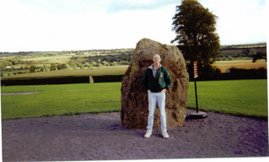Tuesday, January 30, 2007
Ancient Village Uncovered Near Stonehenge
Today, the National Geographic Society announced that an ancient village was uncovered near Stonehenge, and it appears to have been a contemporary site to the mysterious monument. Yahoo News AP wire excerpt:
WASHINGTON - A village of small houses that may have sheltered the builders of the mysterious Stonehenge — or people attending festivals there — has been found by archaeologists studying the stone circle in England. Eight of the houses, with central hearths, have been excavated, and there may be as many as 25 of them, Mike Parker Pearson said Tuesday at a briefing organized by the National Geographic Society.
The ancient houses are at a site known as Durrington Walls, about two miles from Stonehenge. It is also the location of a wooden version of the stone circle.
The village was carbon dated to about 2600 B.C., about the same time Stonehenge was built. The Great Pyramid in Egypt was built at about the same time, said Parker Pearson of Sheffield University.
Julian Thomas of Manchester University noted that both Stonehenge and Durrington Walls have avenues connecting them to the Avon River, indicating a pattern of movement between the sites. "Clearly, this is a place that was of enormous importance," he said of the new find.
The researchers speculated that Durrington Walls was a place for the living and Stonehenge — where cremated remains have been found — was a cemetery and memorial.
Stone tools, animal bones, arrowheads and other artifacts were uncovered in the village. Remains of pigs indicated they were about nine months old when killed, which would mark a midwinter festival. Stonehenge was oriented to face the midsummer sunrise and midwinter sunset, while the wooden circle at Durrington Walls faced the midwinter sunrise and midsummer sunset.
Durrington appears "very much a place of the living," Parker Pearson said. In contrast, no one ever lived at the stone circle at Stonehenge, which was the largest cemetery in Britain of its time. Stonehenge is thought to contain 250 cremations.
The research was supported by the National Geographic Society, Arts & Humanities Research Council, English Heritage and Wessex Archaeology.
It looks like we may be one step closer to finding out who built this fascinating structure. I've never been there, but I've been to Knowth and Newgrange in Ireland, and these places are just as ancient, and just as incomprehensible when one considers the amount of sophistication that went into the work that produced these wonders.
Full Story
Subscribe to:
Post Comments (Atom)

1 comment:
My dear old friend! Glad to see we're both still blogging away.
Post a Comment